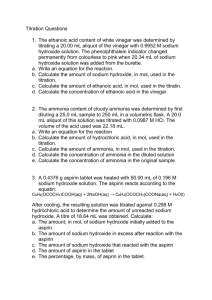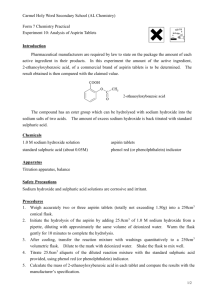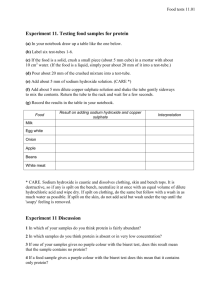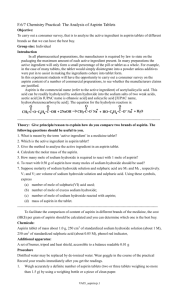Determining the pKa of aspirin
advertisement
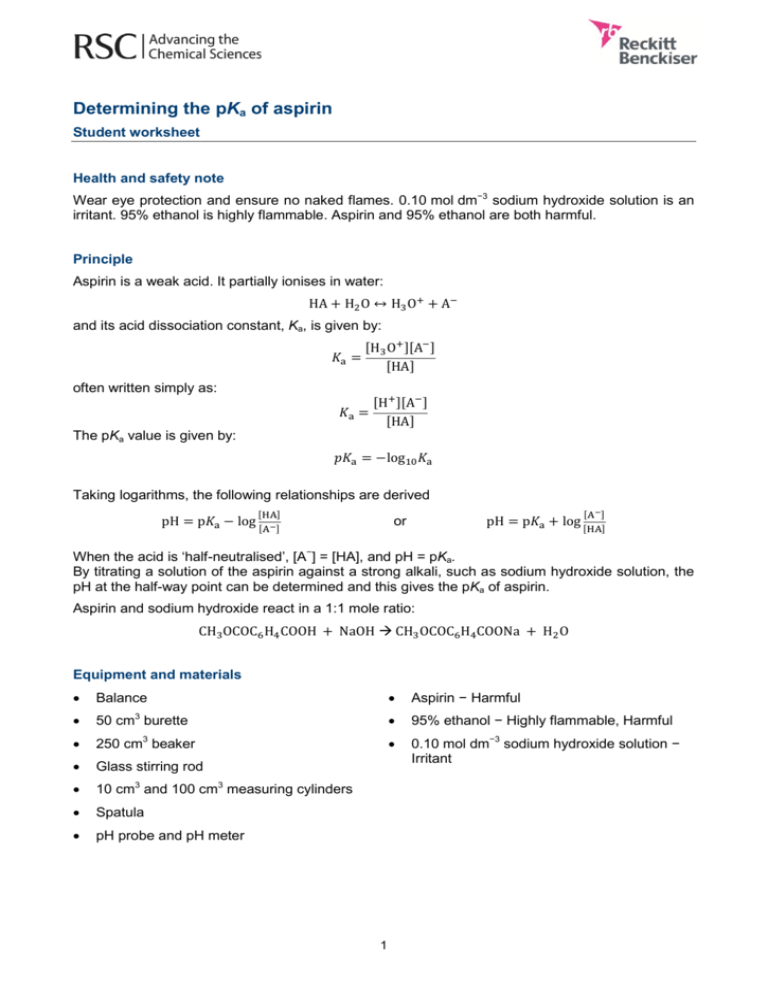
Determining the pKa of aspirin Student worksheet Health and safety note Wear eye protection and ensure no naked flames. 0.10 mol dm−3 sodium hydroxide solution is an irritant. 95% ethanol is highly flammable. Aspirin and 95% ethanol are both harmful. Principle Aspirin is a weak acid. It partially ionises in water: and its acid dissociation constant, Ka, is given by: often written simply as: The pKa value is given by: Taking logarithms, the following relationships are derived or When the acid is ‘half-neutralised’, [A−] = [HA], and pH = pKa. By titrating a solution of the aspirin against a strong alkali, such as sodium hydroxide solution, the pH at the half-way point can be determined and this gives the pKa of aspirin. Aspirin and sodium hydroxide react in a 1:1 mole ratio: Equipment and materials Balance Aspirin − Harmful 50 cm3 burette 95% ethanol − Highly flammable, Harmful 250 cm3 beaker Glass stirring rod 0.10 mol dm−3 sodium hydroxide solution − Irritant 10 cm3 and 100 cm3 measuring cylinders Spatula pH probe and pH meter 1 Method 1. Fill a burette with 0.10 mol dm−3 sodium hydroxide solution. 2. Weigh 0.36 g of aspirin into a 250 cm3 beaker. Add 10 cm3 of 95% ethanol, Stir with a glass rod and when the solid has dissolved add 90 cm3 of deionised water. Stir the mixture until it is homogeneous. 3. Place a pH probe in the solution and connect it to a pH meter. Note: The pH probe should have been calibrated using suitable buffer solutions. 4. Add 2 cm3 quantities of sodium hydroxide solution from the burette to the beaker, stirring well between additions and recording the pH. 5. Near the end-point the pH begins to rise rapidly. So after you have added 18 cm3 of sodium hydroxide solution begin adding it in 0.5 cm3 portions. After about 22 cm3 start adding in 2 cm3 portions again. Continue until total of 36 cm3 has been added. Processing data 12 1. Plot a graph of pH against volume of 0.10 mol dm−3 sodium hydroxide solution added. 2. From the graph, calculate the endpoint of the titration. pH pKa 3. Check this against the expected value by calculating the number of moles of aspirin used (relative molecular mass of aspirin = 180) and, therefore, the volume of 0.10 mol dm−3 sodium hydroxide solution needed to react with it in a 1:1 mole ratio. 8 Half-way point 4. From the graph, estimate the pH at the half-way point of the titration. This gives a value for the pKa of aspirin. 5. End point 2 −3 Calculate the Ka of aspirin. Volume of 0.10 mol dm sodium hydroxide solution added Figure Illustrative titration graph for aspirin against sodium hydroxide solution. 2
